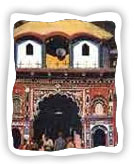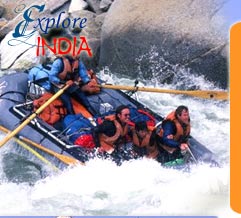 Jammu
and Kashmir Introduction
Jammu
and Kashmir IntroductionJammu and Kashmir are really
three regions: the foothill plains of Jammu; the lakes and blue valleys of
Kashmir rising to alpine passes, the high altitude plains and starkly
beautiful mountains of Ladakh, which lies beyond those passes. It's enough
to move one to poetry. Srinagar is Kashmir's summer capital and Jammu, the
winter capital.
One of Kashmir's greatest attractions are the Dal
Lake houseboats. The Mughal Gardens of Srinagar is another tourist haunt.
Pahalgam, Gulmarg, near Srinagar are picturesque towns, the first a by-route
to Amarnath, the second a premier skiing resort. The famous Shankaracharya
temple is perched high on top of the valley. Jammu is a templed town.
Ladakh, the land of high passes, draws tourists to its Hemis Gompa, Stok
Palace and Museum.
The People: The majority are Muslims
living in the Kashmir valley; culturally and ethnically, the closest links
are with peoples in the northwestern highlands of the Gilgit district in the
Pakistani sector. While Hindus dominate the Jammu region and Ladakh is
majorly influenced by the Trans-Himalayan Buddhism.The Kashmiri language is
influenced by Sanskrit and belongs to the Dardic branch of Indo-Aryan
languages also spoken by the hill tribes of Gilgit. The great majority of
the population resides in the lower reaches of the Vale. Sringar, Jammu and
Kashmir's largest city, is located on the Jhelum River.
Capital: Srinagar, the capital, has a distinctly Central Asian look. It
stands on the Dal Lake ( most of the more modern houseboats are located
here) and the picturesque Jhelum River. Srinagar is also considered to be a
small-sized Lake District. The massive Dal Lake, near the city and Nagin,
the 'Jewel in the ring', a smaller lake, to the north, is dotted with water
lilies. The lakes are mobile shops of moving shikaras. The old city has a
labyrinth of alleyways and mosques.
Culture: The ancient
caves and temples of Kashmir, reveal a strong link with Indian culture at
the beginning of the Christian Era. At one time the classical dances of the
south are believed to have been practised. These arts survived only in folk
forms and were performed principally at marriage ceremonies. The popular
hafiza dance performed by Kashmiri women to the accompaniment of sufiana
kalam was later replaced by the bacha nagma, performed by young boys dressed
like women. The bhand jashna ("festival of clowns"), a 300- to
400-year-old genre of Kashmiri folk theatre performed in village squares,
satirizes social situations through dance, music and clowning.
Occupation:
The majority of the population is engaged in agriculture with rice, being
the staple crop. Many temperate fruits and vegetables are grown in areas
adjacent to urban markets. Kashmir is the sole producer of saffron in the
Indian subcontinent. Cultivation in Ladakh is restricted to the Indus,
Shyok, and Suru river valleys. Cattle breeding is a vital feature of the
economy; the Kashmir goat provides cashmere or pashmina for the production
of fine textiles.
CLIMATE: The climate is one of
opposites: while in summer time the heat builds upto breaking point in the
foothills, people of Ladakh and Kashmir wait for the snow to melt.on the
high passes. From October onwards, Jammu becomes a much more pleasant
destination. However, the best time to enjoy vale of Kashmir and the
adventures of Ladakh region is between the months of May and September.
Population:
9 million
Festivals: Jammu celebrates Lohri and Baisakhi
in February. Every year a 3-day Jammu Crafts Mela is also organised during
Baisakhi at the picturesque Mansar Lake, 60-km from Jammu. Bahu Mela, a
major festival of Jammu region is held at the Kali temple in Bahu Fort,
twice a year during March-April and September-October. In Srinagar, besides
Id other important muslim festivals are Urs at Khaneka in downtown Srinagar
and Urs at Chrar-e-Sharif. The annual Ladakh festival is held in September;
the Hemis Festival features chaams performed by the monks in elaborate
masks.








 Jammu
and Kashmir Introduction
Jammu
and Kashmir Introduction